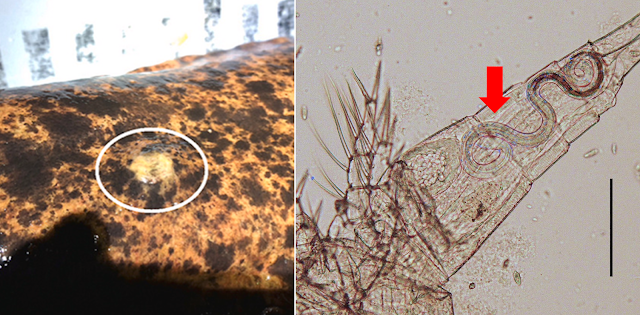Student guest post time! One of the assessments that I set for students in my ZOOL329 Evolutionary Parasitology class is for them to write about a paper that they have read, in the manner of a blog post. The best blog posts from the class are selected for re-posting (with their permission) on here. So from the class of 2025, here is a guest post by Hayley Doggen titled "Sarcocystis: You can’t see me" about a hidden danger in wild deer.
Wild deer and feral pigs are found pretty much everywhere in Australia, which is what makes them such great game animals for hunters. It also makes them really good at spreading parasites to livestock, other wild animals or even to humans. But how much do we really know about the parasites carried by deer and pigs in Australia? Well, compared to other places like the UK, we know very little. In fact, in 2020, when hunters found white cysts in the rump of a wild deer shot in Taree, New South Wales, this was the very first report of a Sarcocystis-like infection in Australian wild deer, even though we already knew that Sarcocystis parasites can live in Australian livestock (including sheep) and wild deer found in other countries.
 |
| A) Image of cysts in a deer caught in Taree which prompted the study; (B) to (D) microscopy images of Sarcocystis in animals caught in the study. All from Figure 3 of the paper. |
Sarcocystis is part of a group of parasites known as Apicomplexa. When these guys are eaten up by their intermediate hosts - usually herbivores (e.g. deer) or omnivores (e.g. pigs) - they pierce the animal’s intestinal wall and, using blood vessels like highways, are able to crawl into the animal’s muscles. Inside the muscles, the Sarcocystis can form special cysts, known as sarcocysts. The sarcocysts begin as a single parasite which then multiplies, expanding the sarcocyst. Inside the cyst, the parasites mature and become infective, ready for when a carnivore eats the parasite’s current host. Often, the cysts are big enough to see with the naked eye, which is why visual inspection of meat is an important part of Australia’s food safety policies. Alas, not all the 200+ species of Sarcocystis form cysts big enough to see. As the researchers in this study found out, some species have cysts which are microscopic.
This post focuses on a study conducted in southeastern Australia, where researchers examined muscle tissues of wild deer and feral pigs for Sarcocystis parasites. Previously, two other studies examining the carcasses of deer in Australia found no signs of infection from Sarcocystis, but after the unique discovery in Taree, these researchers thought the lack of results might be due to the way the meat were examined for parasites. The researchers of this study decided to use different techniques which included mashing the muscle tissue and straining it to find parasites, which were then looked at under a microscope, while their DNA was examined to confirm if the parasite was a species of Sarcocystis.
The researchers confirmed that seven of the animals that they examined had been infected by three different species of Sarcocystis, one of which hasn’t been described before. Five of the animals didn’t have any sarcocysts that were visible to the naked eye, instead they had microscopic cysts. Of the microscopic species found in the feral pigs in this study, they have also been reported in domestic pigs in other countries.
Since this parasite is comfortable in both types of pig, there is the possibility that feral pigs will (or have already) spread the parasite to domestic pigs, especially in the increasingly common free-range farms. This is particularly concerning since the only protection we have in place in Australia against Sarcocystis is visual inspection of meat. So, it is likely that infected meat may make its way into unsuspecting homes.
On top of this, we already know of three species of Sarcocystis that attack humans, causing vomiting and diarrhea among other symptoms. Because of this, it is reasonable to consider the possibility that other species of Sarcocystis, including the one discovered in this study, could leave anyone unfortunate enough to eat infected meat with a really bad day ahead of them.
Reference:
Shamsi, S, Brown, K, Francis, N, Barton, D. P., Jenkins, D. J. (2024) First findings of Sarcocystis species in game deer and feral pigs in Australia. International Journal of Food Microbiology 421: 110780.
